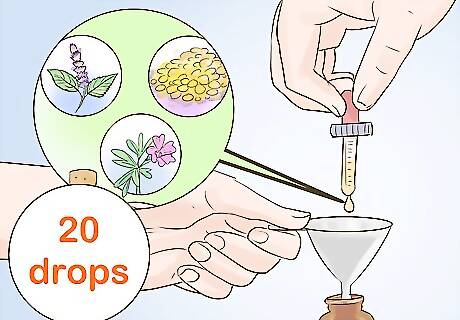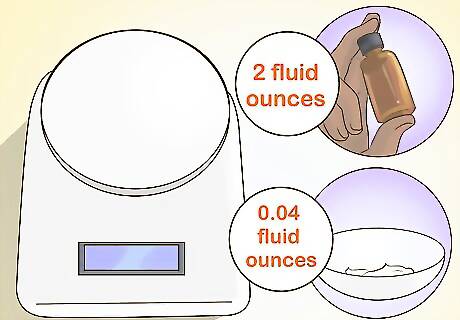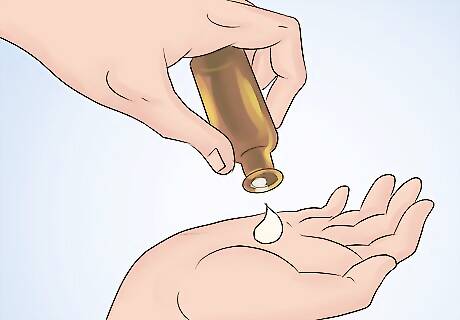
views
X
Research source
Serums that contain this powerful beta-hydroxy acid (BHA) can get pricey, but the good news is you can make a salicylic acid serum at home. Choose carrier oils and essential oils that work best for your skin type, make a salicylic acid paste, and then mix all of your ingredients together in a small vial for easy application.
Choosing Ingredients

Select a carrier oil that suits your skin type. The carrier oil will be the main substance of the serum, so pick one that’s appropriate for the type of skin you have. Jojoba, grapeseed, and argan oil are good for oily or acne-prone skin. Avocado, rosehip seed, and sweet almond oil are good for dry or sensitive skin. Apricot and sunflower oil are good carrier oils for normal skin types. You can use two carrier oils if you want to (i.e. if you want the acne-fighting power of grapeseed oil and the moisturizing properties of avocado oil). Just use half of each in your recipe, rather than the full amount of one.

Choose one to four essential oils that suit your skin type. Essential oils are entirely optional and should only be added if you're not sensitive to fragrances in your skincare. If you do decide to use them, you can stick with just one, or add a few drops of three or four different kinds. Regardless of how many you use, pick essential oils that will be good for your skin type. Choose patchouli, rosemary, or tea tree oil for oily or acne-prone skin. Frankincense, jasmine, and sandalwood oil are good for dry or sensitive skin. Geranium and lavender essential oils are good for all skin types. Test a small amount of each oil on a different part of your skin. If your skin starts to burn, sting, or turn red, you may not not want to use that oil. If you are pregnant, talk to your doctor before using essential oils.

Purchase salicylic acid powder. Shop for salicylic acid powder online through retailers that sell cosmetic ingredients. You could also browse large retailers like Amazon to look for a better deal. Buy a small bag or container if you’re just trying the product for the first time and aren’t sure how much you’ll use. Small amounts (under 30 grams (1.1 oz)) will cost around $5, while larger amounts can cost anywhere between $10 and $20. Store extra powder in a sealed plastic bag or container, and place it in a cool, dark, and dry location.

Use propylene glycol to dissolve your salicylic acid. The salicylic acid powder will need to be dissolved before it’s added to your oils, and the best substance to use is propylene glycol. Purchase a bottle of this from a cosmetic ingredient retailer, or check a nearby drugstore to see if they carry it. You can also use vegetable glycerin as a solvent, but you’ll have to heat it to about 100 °F (38 °C) in a double boiler before adding the salicylic acid. This will ensure that the powder dissolves completely.
Mixing the Ingredients

Find a small glass vial to hold your serum. The vial you choose should be able to hold about 3 fluid ounces (89 mL) and should have a cap that seals. You can select one with a dropper cap or just a regular screw-on cap. Using an amber glass vial will protect your serum from harmful amounts of light.

Pour 2 fluid ounces (59 mL) of your carrier oil into the vial. Measure out 2 fluid ounces (59 mL) of your carrier oil, or use 1 fluid ounce (30 mL) each of two different carrier oils. Prop a funnel in the mouth of the vial and pour your oil into the container.

Add twenty drops of essential oils. If you’ve decided to just use one essential oil in your serum, add twenty drops of it to the carrier oil inside the vial. For two different essential oils, add ten of each, or fifteen and five. Divide the drops up depending on how strong you want each scent to be.

Roll the vial between your palms to mix the oils. Place the cap on your vial and lay the container flat on your palm. Roll it between your hands for about thirty seconds to mix the oils together.

Make a paste of the salicylic acid and propylene glycol. Shake a small amount of the salicylic acid powder into a bowl. Start with about a tablespoon (13 g) of the powder, and then pour in about 1 teaspoon (5 mL) of the propylene glycol. Whisk the two ingredients together until they’re combined in a paste. Try to achieve the consistency of toothpaste. If it’s too dry, add more propylene glycol. If it’s too runny, add more salicylic acid.

Add the paste to the oil at a 2% concentration. Salicylic acid should never exceed a 2% concentration for a leave-on product like a serum. For 2 fluid ounces (59 mL) of oil, add 0.04 fluid ounces (1.2 mL) of salicylic acid paste. To add such a small amount, consider getting a measuring cup that measures amounts as small as 1 milliliter (0.034 fl oz), or use an accurate kitchen scale.

Roll the vial between your palms to mix the paste and oils. Replace the cap and roll the vial between your palms again to mix all the ingredients together. If the paste isn’t mixing well with the oils, shake the vial gently to combine them.

Test the pH of the serum. An effective BHA serum will be acidic but not too acidic. Buy pH testing strips at a drug store or online. Place one end of the strip in your serum. When the strip changes color, compare it to the color chart that comes with the testing kit to see what the pH is. A serum that has a pH between 4 and 5.5 may provide a gentle exfoliation to your skin. If the pH is below 3.5, do not use it. This will be too acidic for your skin. You might end up damaging your skin.
Using and Storing the Serum

Cleanse and tone your face before application. Use your normal face wash to cleanse your skin. Then apply an alcohol-free toner to a cotton pad or ball and gently wipe the toner all over your face. When you’re finished, give your skin about thirty seconds to dry before applying the serum.

Squeeze or tap serum into your palm. If you’re using a cap with a dropper, squeeze about a dime-sized amount of serum onto your palm. If your vial just has a screw-on cap, gently tap the serum out into your hand.

Use a finger to apply drops of serum around your face. Dip a finger into the serum in your palm, then dab the serum onto several spots on your face. Apply a drop to your forehead, one on each cheek, and one on your chin.

Massage the serum in with your fingers. Use gentle, circular strokes to rub the serum into your skin, starting at the spots where you just dabbed it on. Rub the serum all over your face, adding a little bit more to your palm if there wasn’t enough to reach all areas. You can use the serum every day after washing your face, but do not apply it more than twice a day.

Use the serum only on small parts of your body. Salicylic acid can irritate and sting your skin, especially if you have a sensitivity to it. Do not attempt to apply the serum all over your body. If you want to use it on areas other than your face, choose small spots to apply it to. Don't use the serum anywhere that your skin is already irritated.

Wear sunscreen if you'll be outside after applying the serum. Salicylic acid can make your skin more susceptible to sun damage. Any day that you apply the serum and plan to be outside, you should also apply sunscreen. Apply the serum first, then allow it to dry for a minute or two before applying sunscreen.

Store the serum in the fridge for up to two weeks. Because the serum has no preservative, the contents of the vial cannot be stored for an extended period of time. Keep what you’ve made for one to two weeks in the fridge, then dispose of it and make a new batch.



















Comments
0 comment